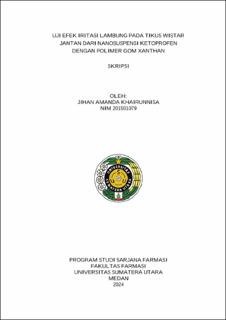Uji Efek Iritasi Lambung pada Tikus Wistar Jantan dari Nanosuspensi Ketoprofen dengan Polimer Gom Xanthan
Gastric Irritation Test on Male Wistar Rats of Ketoprofen Nanosuspension with Xanthan Gum Polymer

Date
2024Author
Khairunnisa, Jihan Amanda
Advisor(s)
Hanum, Tengku Ismanelly
Metadata
Show full item recordAbstract
Background: Ketoprofen can cause gastrointestinal complications that are locally
caused by the direct contact of ketoprofen drug crystals with the gastric mucosa.
Currently, ketoprofen is formulated in enteric-coated tablets, but it does not
completely eliminate irritation. Based on previous research, some users of
ketoprofen experience a greater increase in stomach ulcers compared to non-users.
A solution that can be used to reduce gastric irritation effects is formulating it into
a nanosuspension with xanthan gum polymer as a stabilizer.
Objective: To prove that ketoprofen made using xanthan gum as a stabilizer has
nanoscale particle size and can reduce gastric irritation effects compared to
suspension preparations.
Method: The research stages were carried out by preparing nanosuspension
formulations using the evaporative precipitation method with 0.05% xanthan gum
polymer and Tween 80 surfactant as stabilizers. Male Wistar rats were divided into
8 treatment groups with 3 rats in each group. The test animals were administered
the preparation for 7 days and underwent surgery to obtain gastric specimens. The
parameters for the gastric ulcer index were assessed macroscopically using the
Image-J application and microscopically with the gastric histological score
parameters.
Results: The ketoprofen nanosuspension is liquid, clear, has a characteristic odor,
and shows no sedimentation; pH 5,00,05; particle size of the nanosuspension with
0.05% xanthan gum polymer is 15.62±0.24 nm; polydispersity index 0.3854±0.03;
zeta potential -35.64 mV. The nanosuspension groups (1, 2, 3) have an index value
of 0.00±0.00 mm; the suspension groups (4, 5, 6) have values of 0.013±0.016;
0.059±0.020; 0.089±0.008 mm, respectively; the base (7) and normal (8) groups
have values of 0.007±0.012 and 0.001±0.001 mm, respectively. The histological
scores for groups 1, 2, 3, 4, 7, and 8 are 0.00±0.00; for groups 5 and 6, have values
of 1.33±0.58 and 3.00±1.00, respectively.
Conclusion: Ketoprofen can be formulated into a nanosuspension with a particle
size of < 250 nm. Nanosuspensions of ketoprofen at doses of 50 mg, 100 mg, and
200 mg can reduce gastric irritation with lower ulcer index values and histological
scores compared to ketoprofen suspension.
Collections
- Undergraduate Theses [1719]
